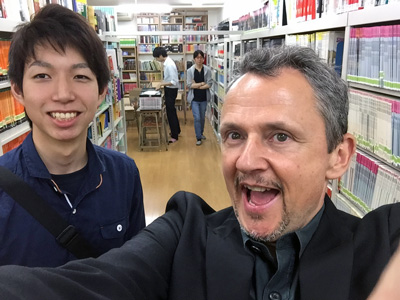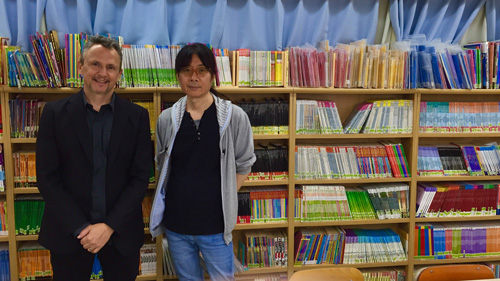Rain pours down on grey streets. The sky turns darker. People rush in and out of the ginormous and labyrinthine Shinjuku Station in Tokyo, popping their umbrellas. As we wait for a taxi, our feet get wet. It’s hot, muggy, and uncomfortable.
But it’s worth the trouble. Our taxi takes us to the famed SEG Campus. SEG stands for the “Scientific Education Group.” Now people may call it an after hours cram school, but it’s different. Word has it that this place loves life-long learning, not just high stakes test prep.
At SEG students study chemistry, mathematics, world history, and English. But we are here for the English program because SEG is big on “TADOKU,” that is, extensive reading, or as I like to call it: Big, Easy Reading. My student is doing a graduation thesis on the topic, and I came with him to observe this famous and extremely successful school.
Today, we are lucky because we will observe a “TADOKU” class taught by the president and founder himself, Dr. Furukawa. The schedule is simple: from 5:15 to 6:25 students read silently. At 6:25 to 6:30, there will be a brief time of “shadowing.” Then at 6:30, students will do a “reading speed check.”
It sounds simple, almost too simple. But there’s more. First, there’s the classroom. There are 36 desks. They fit snugly in the room, but it’s not cramped. There are two flat screen TV’s on either side, but they are not turned on.
Eight boys sit on the left side of the class, and five girls sit on the right. The class starts. Students eagerly read. During the break after the class, they talk about what and how much they read. It’s impressive. But there are two other impressive things. One: wall to wall books. Bookshelves surround us on all sides. In the back and sides of the room, thousands of books stand six shelves high. And the selection is broad. There’s even a shelf in the front of the class, three shelves high under the whiteboard. Dr. Furukawa says there are about 20,000 books in this classroom, and he has 28 classrooms just like it. That’s over 500,000 books. As far as books go, this is impressive.
Then there is the impressive Dr. Furukawa himself, with his long hair in a pony tail and his horn rimmed glasses. He’s a book guru, mathematics wiz, and the boss of a company that, according to the SEG website, grossed 13.5 billion yen last year. He is the most impressive factor and actor in this room because he appears to know all the books, and he sometimes disappears and brings books from other rooms as well. As we observe, he brings us many books with a smile on his face. And we read.
I read Piggybook, a story about a typical family, 2 boys, a father, and a mother. The mother works tirelessly for the boys and father who take her for granted. And there are pictures of pigs hidden all over the book, on doorknobs, faucets, and wall sockets. Eventually, the wife leaves, leaving a note that says, “You are pigs.” With the mother gone, the men are lost, and the house turns into a pigsty. And just as all hope is gone, the mother returns. There are apologies and forgiveness. The boys and the father begin to help around the house. The wife fixes the car. It’s an amazing story. And it packs a punch.
Dr. Furukawa is not messing around. He gives me Out, a gay coming out story. A girl falls in love with a boy, with whom she has been friends forever. Just as she is about to confess her love, the boy comes out to her. He’s gay. She is broken-hearted, and her love remains silent to the end. Dr. Furukawa gives us a “Three Little Pigs” story, turned upside down. It’s the three wolves. They are good; the pig is mean and badass. But at the end, the story has a great twist of kindness. He gives me a book about a tadpole and caterpillar, which tells of a budding love and a break up. Time passes. Separated, the now butterfly and frog long for each other. The butterfly returns, looking to reconcile, only to be eaten by the frog who, after his meal, continues to long for his love. I read a story called The Harmonica from Iranian cinema, and another called Clueless George, which is a Curious George style illustrated slam on George Bush, Dick Cheney, and Karl Rove. Boom!
I find the recommendations mesmerizing. The choices are bold, and they work for me. Furukawa is an expert book whisperer. And he knows it. He walks around the room passing out books left and right, and the students read. It’s the best session of free voluntary reading I’ve ever seen, supported by a superb classroom library and Dr. Furukawa’s wizardry with books.
Near the end, we do 5 minutes of Shadowing. Dr. Furukawa plays a tape. Students shadow aloud as they listen to and read the text. The tape is loud and clear! The students shadow it twice. Done.
After the shadowing activity, we do a timed-reading. Dr. Furukawa gives us a timer. Hit start. Read the story. Hit stop. Then answer the questions. As we read, answer sheets are passed out. We check our answers and write down our reading times. Class is over!
After class, Dr. Furukawa looks at my student’s reading speed time and says “slow.” Ouch. He looks at mine and says, “fast.” He leaves and comes back with the classes timed-reading results. Some are slow, but some are even faster than mine. Wow!
After a break, Neil comes in, a native speaker from New Zealand who leads the next session. The students are boisterous, but they work on meaning-based, communicative activities, not drills, and not high stakes test prep. It’s intensive reading, but done well. Great students, keen on study; they talk noisily in Japanese, but always about the lesson. Neil expertly manages this content-based class, and he keeps the focus on learning interesting content through English. During the whole evening, Neil and Dr. Furukawa say nothing about tests, exams, and getting ready for examination hell. It’s real education, a curiosity-filled time of learning.
Today it’s just 2 classes; there’s so much more to take in, but not enough time. Afterwards Dr. Furukawa shows us SEG’s book storage room. Tons of books. Multiple copies. Books in boxes waiting to be stacked. Overwhelmed, I asked to come back to learn more about all the books. Dr. Furukawa kindly agrees.
We say “Goodbye” and “Thank you” and walk away into the Tokyo night; the rain has stopped, and the sky is clearing. I’m impressed, inspired, and deluged. This seems like after school education at its best. But how can one learn to be a book whisperer like Dr. Furukawa? Since his knowledge of books seems encyclopedic and his ability to “book whisper” seems telepathic, before leaving I ask him where he finds time to read. He says, “in the schema.”
Perhaps this is a Japanese usage of the Greek word, meaning “form or figure.” But it’s an answer that big readers often say. Read in the schema. Find time to read in the cracks and corners of daily life. Make reading a part of the form, figure, and contour of your time on earth. Teach your students to do the same. This is one way to open up, change yourself and the world around you. Because reading is change, read whenever and wherever you can — because curiosity, language, and life ask it of you.



